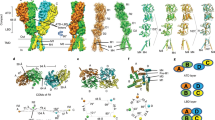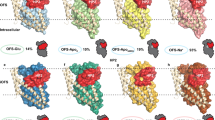Abstract
THE possibility that L-glutamate and L-aspartate are excitatory transmitters in the CNS is supported by neurochemical and neurophysiological evidence1. The problems of identifying particular synapses that are excited by one or the other of these dicarboxylic amino acids, and distinguishing between the two receptors are, however, more difficult. At the recent International Meeting of Neurochemistry (September 1975) Graham summarised some of the evidence favouring distinct functions for the two amino acids, concentrating on the possible transmitter role of L-aspartate. For example, a higher content of this amino acid is found in the ventral than in the dorsal grey matter of the spinal cord2, aortic occlusion leads to loss of aspartate content and degeneration of small neurones3, reduction in aspartate content is seen in the spinal cord after section of dorsal roots4 and in the olfactory cortex after olfactory bulbectomy5, which also decreases glutamate. Renshaw cells are slightly more sensitive to the ionotophoretic administration of L-aspartate while the reverse is true of interneurones of the dorsal spinal horn6. It is possible that L-glutamate and L-aspartate, being flexible molecules, fold or unfold and could interact with either receptor and McCulloch et al.7 accordingly used kainate, a conformational restricted analogue of glutamic acid, which would be unlikely to fold to occupy the aspartate receptor, and N-methyl-D-aspartate, which would be too small to interact with the glutamate receptor (Fig. 1). The difference in sensitivity between the two groups of neurones to these agonists was much greater: the Renshaw cells were much more sensitive to N-methyl-D-aspartate and the dorsal interneurones to kainate7.
This is a preview of subscription content, access via your institution
Access options
Subscribe to this journal
Receive 51 print issues and online access
$199.00 per year
only $3.90 per issue
Buy this article
- Purchase on Springer Link
- Instant access to full article PDF
Prices may be subject to local taxes which are calculated during checkout
Similar content being viewed by others
References
Curtis, D. R., et al., Brain Res., 4, 283 (1972).
Graham, L. T., Jr, Shank, R. P., Werman, R., and Aprison, M. H., J. Neurochem, 14, 465 (1967).
Davidoff, R. A., Graham, L. T., Jr, Shank, R. P., Werman, R., and Aprison, M. H., J. Neurochem., 14, 1025 (1967).
Jones, I. M., Jordan, C. C., Morton, I. K. M., Stagg, C. J., and Webster, R. A., J. Neurochem., 23, 1239 (1974).
Harvey, J. A., Schofield, C. N., Graham, L. T., Jr, and Aprison, M. H., J. Neurochem., 24, 445 (1975).
Duggan, A. W., Expl Brain Res., 19, 522 (1974).
McCulloch, R. M., Johnston, G. A. R., Game, C. J. A., and Curtis, D. R., Expl Brain Res., 21, 515 (1974).
Lunt, G. G., Comp. gen. Pharmac., 4, 75 (1973).
Fiszer de Plazas, S., and De Robertis, E., FEBS Lett., 33, 45 (1973).
Fiszer de Plazas, S., and De Robertis, E., J. Neurochem., 23, 1115 (1974).
De Robertis, E., and Fiszer de Plazas, S., J. Neurochem., 23, 1121 (1974).
De Robertis, E., and Fiszer de Plazas, S., J. Neurochem. (in the press).
Folch-Pi, J., and Lees, M., J. biol. Chem., 191, 807 (1951).
De Robertis, E., Fiszer, S., Pasquini, J., and Soto, E. F., J. Neurobiol., 1, 41 (1969).
McLennan, H., Marshall, K. C., and Huffman, R. D., Experientia, 27, 1116 (1971).
Duggan, A. W., Lodge, D., Biscoe, T. J., and Headley, P. M., Archs int Pharmacodyn. Therap., 204, 147 (1973).
Johnston, G. A. R., Curtis, D. R., Davies, J., and McCulloch, R. M., Nature, 248, 804 (1974).
Wofsey, A. R., Kuhar, M. J., and Snyder, S. H., Proc. natn. Acad. Sci. U.S.A., 68, 1102 (1971).
Balcar, V. J., and Johnston, G. A. R., J. Neurochem., 19, 2657 (1972).
Author information
Authors and Affiliations
Rights and permissions
About this article
Cite this article
DE ROBERTIS, E., DE PLAZAS, S. Differentiation of L-aspartate and L-glutamate high-affinity binding sites in a protein fraction isolated from rat cerebral cortex. Nature 260, 347–349 (1976). https://doi.org/10.1038/260347a0
Received:
Accepted:
Issue Date:
DOI: https://doi.org/10.1038/260347a0
This article is cited by
-
Inhibition by N-acetyl-aspartate of aspartate binding to a proteolipid fraction from rat cerebral cortex
Neurochemical Research (1984)
-
The convulsant drugs 3-mercaptopropionate and methionine sulfoximine inhibitl-glutamate andl-aspartate binding to a hydrophobic protein fraction from rat cerebral cortex
Neurochemical Research (1979)
Comments
By submitting a comment you agree to abide by our Terms and Community Guidelines. If you find something abusive or that does not comply with our terms or guidelines please flag it as inappropriate.



